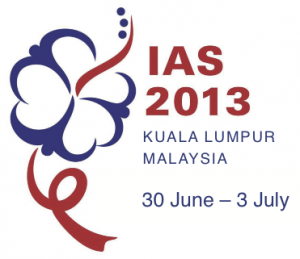Elvitegravir/cobicisat/tenofovir/FTC: Stribild studies at IAS 2013
25 July 2013. Related: Conference reports, Antiretrovirals, IAS 7th Kuala Lumpur 2013.

Simon Collins, HIV i-Base
Several posters at the IAS conference presented generally supportive results for the fixed-dose integrase inhibitor-based combination of elvitegravir/cobicistat/tenofovir/FTC (Stribild).
A poster from Frank Post from University College London and colleagues looked at the concern about renal safety. [1]
The current license for Stribild restricts use to patients with creatinine clearance (CrCl) based on estimated GFR >/= 70 mL/min as this was an entry criteria in the registrational phase 3 studies.
The new study was a phase 3, open-label, multicenter, two-cohort study in HIV positive patients with CrCl from 50 to 89 mL/min. The analysis for Stribild was based on 33 treatment naive patients and the analysis for cobicistat was based on 73 people who were virally suppressed on stable PI/r-based combinations who switched ritonavir to cobicistat.
Baseline CrCl (median [IQR]) was 73 mL/min (65 to 81) and 71 mL/min (62 to 81) in the Stribild and cobicistat cohorts, with small reductions at week 24 in both groups (-5 mL/min [-13 to 1] and -4 mL/min [-7 to 2] respectively).
No changes in actual GFR (rather than estimated GFR) were reported in the small number of patients (n=14) who had this measured. No renal events were reported, although three patients discontinued Stribild due to reduced CrCl, which resolved on stopping treatment; none with features of proximal tubulopathy.
David Cooper from St Vincent’s Hospital, Sydney and colleagues presented pooled analyses from two registrational phase 3 studies (n=1408 including active and control patients). They reported similar rates of viral suppression and clinical results by gender, age (above vs below 40 years old) and race (white vs non-white); and by baseline CD4 and viral load. [2]
These results were supported by pooled pharmacokinteic analyses from earlier studies in the development programme in HIV positive and HIV negative people. This study pooled results from nine studies for elvitegravir and tenofovir and from 16 studies for cobicistat. No differences were seen in a wide range of demographic and HIV factors including by race (white/black/Asian/Latino/Hispanic), baseline viral load (above and below 100,000 copies/mL) or CD4 count (above or below 200 cells/mm3). [3]
Early results from a 48 week study from one of the many switching studies currently supported by Gilead were presented as a poster. [4]
The study enrolled 48 patients who were stable (viral load <50 copies/mL for greater than six months – median duration was 34 months) on raltegravir-based combinations. At week 24 all patients maintained viral load <50 copies/mL.
Finally, a study of a post hoc analysis of the impact of less than 95% adherence with Stribild compared to Atripla was also presented as a poster. [5]
Median adherence, assessed by pill count through to week 96, was 98% in each arm. However, <95% adherence was reported by 26% vs 25% and <90% by 7% vs 11% in the Stribild vs Atripla groups respectively. There were no statistically significant differences in rate of viral suppression by adherence level between the two treatment groups.
References:
Unless stated otherwise, references are to the Programme and Abstracts for the 7th IAS Conference on HIV Pathogenesis, Treatment and Prevention 30 June – 3 July 2013, Kuala Lumpur.
- Post F et al. Renal safety of elvitegravir/cobicistat/emtricitabine/tenofovir DF (STB) and cobicistat-boosted protease inhibitor regimens in HIV-1-infected patients with mild to moderate renal impairment. 7th IAS, 30 June – 3 July 2013, Kuala Lumpur. Poster abstract TUPE280.
http://pag.ias2013.org/abstracts.aspx?aid=956 - Cooper D et al. Subgroup analyses of 96-week efficacy and safety of elvitegravir/cobicistat/emtricitabine/tenofovir DF. 7th IAS, 30 June – 3 July 2013, Kuala Lumpur. Poster abstract TUPE281.
http://pag.ias2013.org/abstracts.aspx?aid=959 - Custodi JM et al. A large population pharmacokinetic evaluation of the influence of demographic and HIV disease factors on the pharmacokinetics of elvitegravir, cobicistat and tenofovir. 7th IAS, 30 June – 3 July 2013, Kuala Lumpur. Poster abstract MOPE036.
http://pag.ias2013.org/abstracts.aspx?aid=2577 - Crofoot G et al. Safety and tolerability of switching from twice daily raltegravir plus truvada to STRIBILD in virologically suppressed, HIV-1-infected subjects at week 24. 7th IAS, 30 June – 3 July 2013, Kuala Lumpur. Poster abstract TUPE283.
http://pag.ias2013.org/abstracts.aspx?aid=1690 - Shalit P et al. Elvitegravir/cobicistat/emtricitabine/tenofovir DF demonstrates comparable efficacy to efavirenz/emtricitabine/tenofovir DF in subjects with adherence < 95%. 7th IAS, 30 June – 3 July 2013, Kuala Lumpur. Poster abstract TUPE283.
http://pag.ias2013.org/abstracts.aspx?aid=990 (abstract)
http://pag.ias2013.org/EPosterHandler.axd?aid=990 (PDF poster)

